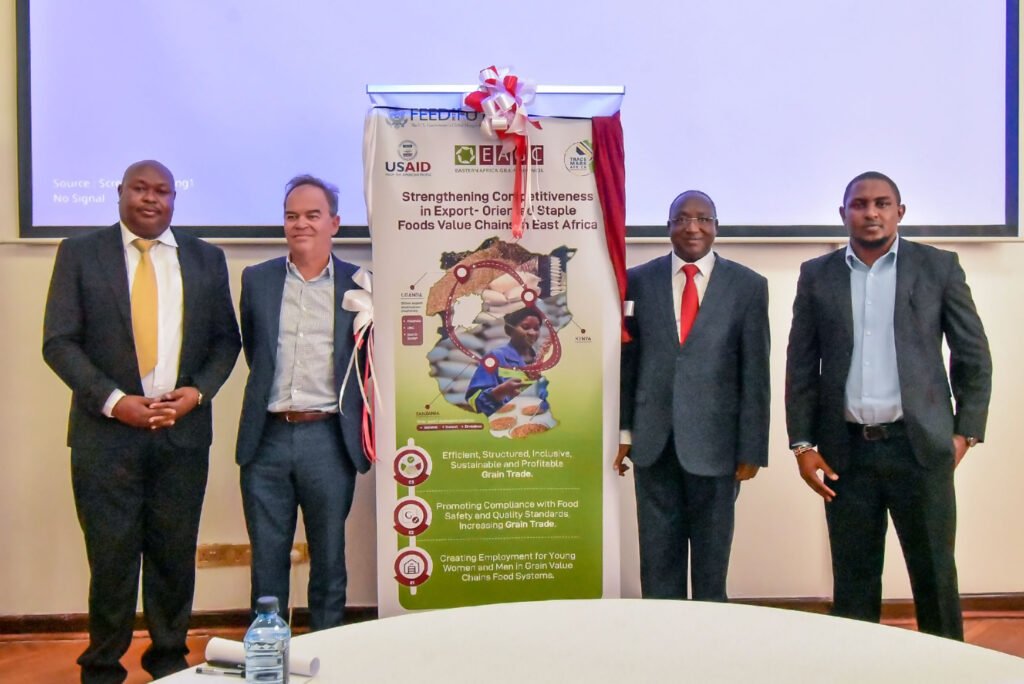By Zablon Oyugi, April 4, 2024, The Eastern Africa Grain Council (EAGC) and Trademark Africa (TMA) have launched a three-year project that will focus on facilitating export-oriented staple grains trade to be implemented in Kenya, Tanzania and Uganda.
The project dubbed “Strengthening Competitiveness in Export-Oriented Staple Food Value Chains in East Africa” under the USAID funded “Economic Recovery and Resilience Activities (ERRA)” program will see Kenya become the destination market and Tanzania and Uganda as suppliers due to their surplus production.
This comes at a time the food commodities trade faces significant instability and decline due to challenges such as low aggregation, informal trading, and limited farmer integration into formal trade which have resulted in high transactional costs.
Inadequate storage and quality management infrastructure, coupled with a lack of post-harvest handling skills and knowledge, further exacerbate the situation. Additionally, there is limited information on export market opportunities, inadequate access to quality management services, and a scarcity of finance for trade and infrastructure development.
High logistical costs due to inefficiencies in road transport and delays in cross-border processing, along with weak regulatory enforcement, further compound these challenges.
Giving his remarks Gerald Masila, Executive Director of EAGC, voiced his excitement with the launch of the project, emphasizing its alignment with EAGC’s mission to advocate for an enabling environment and promote structured grain trade for optimum benefits of its stakeholders.
“We expect more benefits as a result of the project to the sector, such as improved production, access to agricultural financing, capacity enhancement, and mentorship in SPS and quality compliance, trade linkages and an enabling environment for trade,” said Masila yesterday during the project launch in Nairobi.
Project objectives
Attended by over sixty stakeholders of the staple grains value chain actors, the project aims to achieve several objectives.
Firstly, it seeks to strengthen farmer-operated grain business hubs (G-Hubs), enabling them to utilize technology to enhance grain production, quality, and trade.
Additionally, the project aims to develop enterprise-level capacities and institutional mechanisms to scale up Sanitary and Phytosanitary (SPS) standards and quality compliance, thereby increasing export-oriented grain trade.
Furthermore, it aims to establish and enhance an information hub to inform regional food balance sheets and shape national and regional food security and trade policies, fostering an enabling regulatory environment for trade.
Joseph Kimote, Vice Chairman and Kenya Country Director of EAGC, highlighted the project’s goal of fostering collaboration and innovation within the staple food value chains. “By empowering farmers and strengthening market linkages among SMEs, we aim to create a more resilient and inclusive grain sector in East Africa,” he remarked.
Enhancing smallholder farmers, traders’ capacity
On his part, Mark Priestley, Chief of Party for the ERRA project at TradeMark Africa, emphasized the strategic collaboration with EAGC and USAID, highlighting its potential to enhance grain exports within the region through strategies such as Grain Business Hubs (G-Hubs), operated by farmers, who will utilize technology to enhance grain quality and stimulate trade.
Key intervention areas of the project will focus on commercialization of small holder farmers’ activities, SME businesses, and improving the grain trade policy environment for staple foods export.
The project will enhance export-oriented market access for Tanzania and Uganda with the Kenyan market, promoting greater regional integration and trade through empowering smallholder farmers by improving their access to relevant Business Development Services (BDS), thereby enhancing production and trade efficiency.
Furthermore, it will strengthen the capacity of firms along the grains export value chain in Uganda and Tanzania, enabling them to capitalize on export opportunities and contribute to economic growth.







